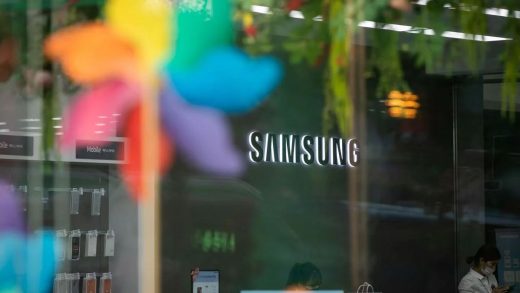:format(webp)/https://www.thestar.com/content/dam/thestar/entertainment/stage/2023/04/23/whats-in-a-page-to-print-theatre-programs-or-deliver-them-digitally-that-is-the-question/rock_of_ages_giant_onstage_qr_code.jpg)
Beware: when attending the musical “Rock of Ages” at Toronto’s Elgin Theatre, your cellphone might develop a life of its own.
Through Bluetooth technology and the user-downloaded Appix app, the show takes control of phones, turning on the flashlight during ballads and sending out the lyrics to banger hits to encourage audience sing-along (take that, audience etiquette purists!).
While “Rock of Ages” is set in the 1980s, this use of technology is intended to transform it into “a modern-day rock spectacle,” said a spokesperson for the show’s producer, More Entertainment.
The spectacle is accomplished via the use of a QR code, that little black-and-white square containing encoded data that became ubiquitous during the pandemic. A huge QR code is projected onto the “Rock of Ages” set as the audience enters, and scanning it allows spectators to opt into the interactive elements.
This is doubtless the most adventurous use of QR codes on the Toronto performing arts scene, but it’s becoming increasingly common to see QR codes in theatre settings.
Alongside this has blossomed a culture of QR code hating. Some of the arguments against: they’re depersonalizing, they exclude the non-tech-savvy and they may be dangerous from a cybersecurity perspective.
In theatre circles, while QR codes have become familiar in ticketing and are sometimes also used for concession menus, the real flashpoint of debate is show programs: traditionally, printed booklets with information about cast, creative team and production sponsors, and sometimes bonus content including playwrights’ and directors’ notes and related articles.
During the pandemic, performing arts organizations that created digital content had no choice but to make programs digital too, including them as PDFs or pages on their websites. As in-person theatre returned to Toronto and the GTA, many of these organizations continued to create digital programs accessed by QR codes.
Many theatregoers are unimpressed.
Keith Perrott, who has been attending theatre in Toronto for nearly 55 years, doesn’t own a cellphone and can’t scan a QR code. Downloading a digital program from a theatre’s website onto his computer “is a very poor second choice,” he said.
Perrott has saved all his programs over the decades. “They become a kind of diary. It’s fun to look at old programs and find the names of people, often bit players, who went on to become major stars,” he said.
James Kall is also not a QR code fan. “When I attend the theatre, it is an event,” said the actor, who played Nick and others in the Toronto company of “Come From Away” and is currently performing in the show’s North American tour.
“I look forward to sharing my ticket with the usher and receiving a program of the night’s entertainment,” said Kall. Such rituals “separate live theatre from the film industry. That performance that night with that company will never be duplicated.”
And then there’s meeting his fans: “I find it difficult to autograph a QR code on someone’s phone,” said Kall.
It’s not just senior figures who are print program loyalists. Actor/director Steven Hao graduated from Toronto Metropolitan University’s School of Performance in 2022 and has a print program collection. “Growing up as a theatre nerd, it’s part of the job,” he said.
These strong feelings about programs are in keeping with other responses to shifts in publishing, said TMU associate professor Joanne McNeish, whose research focuses on consumer resistance to the adoption of new technologies.
Programs act as bridges between the spectator and the theatrical experience, and are part of the “magic of being in the theatre,” said McNeish. If an audience member has to take out their phone to scan a QR code, that can feel like “work that takes me back to my regular life.”
There’s also something contradictory about having to take out your phone to access a program, given that we’re otherwise told to turn our phones off so that calls and notifications don’t disrupt the performance.
A frequent argument in favour of QR codes is that they reduce the use of paper and are better for the environment, something theatre organizations including Canadian Stage, Tarragon, Soulpepper and More Entertainment mentioned to the Star. They cited concerns about the environment as motivation to reduce their use of print programs.
But McNeish calls this “greenwashing.”
While the creation of any new object does “some damage to the environment across the board,” said McNeish, the paper industry is environmentally responsible in comparison to other industries. “Paper began its sustainable journey in the 1970s … They are actually the best example of the circular economy as a method of sustainability.”
Another concern is budget: “Post-pandemic, printing costs skyrocketed,” said Cameron Johnston, Tarragon’s director of marketing and communications. That was the final straw that led Tarragon to adopt digital programs, a direction it had been heading before the pandemic.
This season, Tarragon distributed single-sheet handbills with basic show information and a QR code to access a full-length program. It laminated a limited number of full programs to lend to audience members who asked for a nondigital option.
There were some savings, but limited ones thanks to those inflated printing costs, said Johnston: while it cost the theatre $900 to $1,500 for 2,000 to 4,000 programs before the pandemic, it recently spent $800 for just 1,000 programs.
Feedback has been evenly split about this new approach and Johnston said the theatre is still deciding whether to move back to print programs next season.
Both Canadian Stage and the Stratford Festival have gone hybrid, offering print programs and posting QR codes for digital versions at entry points to their auditoriums.
For its 2022-23 season, Canadian Stage is printing about 50 per cent of its pre-pandemic program order. Stratford’s audiences, though, are clearly print-program loyal.
Last year, the festival printed nearly 167,000 show programs (including a reprint after the first run ran out), while there were only 921 downloads of digital programs. This season Stratford is printing 60 per cent of the programs it printed before the pandemic.
Sixty-seat Assembly Theatre in Toronto’s Parkdale neighbourhood is not printing programs for its upcoming production of “Bone Cage” in May: “It’s more of a financial decision” than anything philosophical, said artistic director Cass Van Wyck.
One company that’s not gone the QR route is Mirvish Productions. While digital versions of its programs are available, the company is printing and distributing as many programs now as before the pandemic. “For our audience, that is what works,” said John Karastamatis, Mirvish’s director of communications and programming.
Contracts between unions and theatre producers are a further complicating factor. The Canadian Actors’ Equity Association requires that the names of actors and other artists it represents be published by the producing company.
Traditionally, this would happen in a print program, but during the pandemic the association was “amenable to theatres providing that information in a nonprint format,” said Randy Duniz, the organization’s communications director. Whether or not this policy should evolve “is on our radar as something we may want to address in our collective agreements,” he added.
Given all this, the jury is still out on whether theatre programs will disappear into the black-and-white square for good. Perhaps the ultimate current expression of this ambivalent period for theatre programs is the current trend of taking pictures of a show program while in the theatre and posting them on Instagram and Twitter. You can’t do that with a QR code.
JOIN THE CONVERSATION
does not endorse these opinions.

:format(webp)/https://www.thestar.com/content/dam/thestar/entertainment/stage/2023/04/23/whats-in-a-page-to-print-theatre-programs-or-deliver-them-digitally-that-is-the-question/steven_hao_holding_program.jpg)
:format(webp)/https://www.thestar.com/content/dam/thestar/entertainment/stage/2023/04/23/whats-in-a-page-to-print-theatre-programs-or-deliver-them-digitally-that-is-the-question/autographed_program.jpg)



